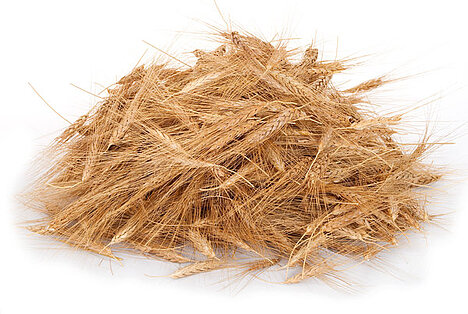Wheat germ

Wheat germ is the most nutritious part of the wheat kernel and contains many valuable vitamins, minerals, proteins and fats. They can provide your dog with many health benefits if you feed them correctly. In this article, you will find out what wheat germ is, how it can help your dog and how best to feed it.
What are wheat germs?
Wheat germ is the sprout of wheat that sprouts from the grain when it begins to germinate. They make up only about 2.5% of the weight of the grain, but contain most of the nutrients. Wheat germ is rich in omega-3 fatty acids, which are important for your dog's skin and coat health and can reduce inflammation. They also provide vitamin E, which is a powerful antioxidant and can protect your dog's heart and liver. Other important ingredients include B vitamins, magnesium, zinc, iron and selenium.
How can wheat germ help your dog?
Wheat germ can help your dog in different ways, depending on their individual needs and health status. Here are some possible benefits of wheat germ for dogs:
- They can improve your dog's skin and coat health by moisturizing, relieving itchiness, and preventing dandruff.
- They can reduce inflammatory conditions such as arthritis, allergies or skin problems by inhibiting the production of pro-inflammatory substances.
- They can strengthen your dog's immune system by fighting free radicals and promoting cellular health.
- They can support your dog's digestion by providing fiber that stimulates bowel movement and prevents constipation.
- They can increase your dog's energy and vitality by providing high-quality proteins and carbohydrates that can be utilized quickly.
How do you feed wheat germ to your dog?
You can buy wheat germ in various forms, for example as an oil, tablet or powder. You can simply mix it with your dog's food or give it as a treat between meals. The recommended amount depends on your dog's age, weight and health, but a general guideline is one tablespoon of wheat germ per pound of food. However, you should always consult your veterinarian before giving your dog any new foods or supplements to avoid possible side effects or intolerances.
Are there any disadvantages or risks to feeding wheat germ?
Wheat germ is generally safe for dogs as long as you feed it in moderation and pay attention to the quality. However, there are a few things you should consider before giving your dog wheat germ:
- Wheat germ is very high in calories and can lead to obesity if you feed it too often or too much. Therefore, pay attention to your dog's total calorie intake and reduce other food ingredients if necessary.
- Wheat germ can cause allergies or intolerances if your dog is sensitive to gluten or other wheat ingredients. Therefore, monitor your dog's reaction to wheat germ and stop feeding immediately if there are signs of diarrhea, vomiting, itching or a skin rash.
- Wheat germ can become rancid if it is not stored properly. Therefore, only buy fresh wheat germ and store it in a cool, dry place. Use them within the best-before date and dispose of them if they smell or taste unpleasant.
Wheat germ is a nutrient-rich supplement for dogs that can provide many health benefits. They can improve your dog's skin and coat health, anti-inflammation, immune system, digestion and energy levels.
If you notice any signs of hypersensitivity or poisoning in your dog, you should see your vet immediately. We are not a substitute for a vet, but we try to be as accurate as possible. Every dog reacts differently and we recommend you get a second opinion or consult your vet if in doubt.
Stay healthy and take good care of your four-legged friend!😊